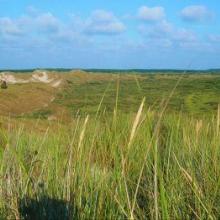
Duinen Terschelling
- Country:Netherlands (Kingdom of the)
- Site number:2215
- Area:4,040.3 ha
- Designation date:29-08-2000
- Coordinates:53°23'N 05°18'E
- Transboundary Site:
- Duinen Ameland (Netherlands (Kingdom of the))
- Duinen Schiermonnikoog (Netherlands (Kingdom of the))
- Duinen Vlieland (Netherlands (Kingdom of the))
- Duinen en Lage Land Texel (Netherlands (Kingdom of the))
- Hamburgisches Wattenmeer (Germany)
- North Sea Coastal Area (Netherlands (Kingdom of the))
- Schleswig-Holstein Wadden Sea and adjacent areas (Germany)
- Vadehavet (Denmark)
- Wadden Sea (Netherlands (Kingdom of the))
- Wattenmeer, Elbe-Weser-Dreieck (Germany)
- Wattenmeer, Jadebusen & westliche Wesermündung (Germany)
- Wattenmeer, Ostfriesisches Wattenmeer & Dollart (Germany)
Materials presented on this website, particularly maps and territorial information, are as-is and as-available based on available data and do not imply the expression of any opinion whatsoever on the part of the Secretariat of the Ramsar Convention concerning the legal status of any country, territory, city or area, or of its authorities, or concerning the delimitation of its frontiers or boundaries.
Overview
Duinen Terschelling is one of the larger islands in the Wadden Sea, characterized by sand dunes and an extensive intertidal mudflat surrounded by grassland, conifer crops, small villages and silt polders claimed from the sea. The Site was formerly part of Ramsar Site 1252 (Waddeneilanden, Noordzeekustzone, Breebaart) which was divided in six Sites following Natura 2000 borders in 2014. The site is of international importance for European threatened species of breeding birds such as little tern, northern harrier and western marsh harrier, and endangered species of flora such as pigmy rush and green-winged orchid. The dunes form a natural coastal defence against the erosive forces of the North Sea and they retain rain water ensuring freshwater supply. Human activities include tourism, conservation and research. The main threats to the Site’s ecological character are posed by groundwater extraction and tourism.
Transboundary designation:
The "Wadden Sea" Transboundary Ramsar Site was declared in 2015 and it includes 13 Ramsar Sites in Denmark, Germany and the Netherlands: Site No. 356 in Denmark; Sites No. 501, 537, 80, 81, 82 in Germany; Sites No. 1252, 289, 2212, 2213, 2214, 2215, 2216 in the Netherlands.
Administrative region:
Province of Friesland
- National legal designation:
- National Ecological Network (NEN) - Duinen Terschelling
- Regional (international) legal designations:
- EU Natura 2000
- Last publication date:15-07-2022
